This September and October, we’re taking a look at the jam-packed 1994 to 1995 season of Star Trek, including Star Trek: Deep Space Nine and Star Trek: Voyager. Check back daily for the latest review.
In many ways, Heroes and Demons is a watershed moment for Star Trek: Voyager. The two previous episodes, Prime Factors and State of Flux, may have been far from perfect, but they did at least hint at a direction for the show. They suggested that maybe Voyager might be interested in engaging in some of the big philosophical questions raised by the crew’s unique situation. Stranded seventy thousand light-years from home, the ship was cut off from the Federation. It was isolated and alone. That meant that tough choices at least had to be debated.
While neither Prime Factors nor State of Flux made for particularly exciting television, they were episodes that felt specific to Voyager in a way that a lot of the first season really doesn’t. Unfortunately, Heroes and Demons represents a step backwards. Far from telling a story specific to Star Trek: Voyager, this feels like a script that could easily have been recycled from Star Trek: The Next Generation or Star Trek: Deep Space Nine.
It’s written by veteran Next Generation writer Naren Shankar, who had also served on the staff of Deep Space Nine. He wrote Heroes and Demons as a freelancer, pitching the idea very early in the development cycle. Perhaps what is most remarkable is how little of Shankar’s script was adapted or edited from that first draft. In fact he described it to The Official Star Trek: Voyager Magazine as “the best experience I’ve ever had as a writer, in terms of writing something as a first draft and then seeing those exact words on screen.”
There’s a sense that Heroes and Demons is a fun story that could have really worked in any context, and doesn’t fit particularly well into the mould of Voyager‘s first season. This should be the year where Voyager is trying to find its own voice, rather than simply imitating that of its older siblings.
Of course, there is very likely a reason for the sudden shift in tone and design between State of Flux and Heroes and Demons. Michael Piller has begun to step away from Voyager a bit. Although he would not retreat quite as far from the show as he had from Deep Space Nine, there was a sense that Piller was trying to spread his wings creatively. As well as launching Voyager as the flagship show for the new network, Piller was also producing the sci-fi Western Legend for UPN at the same time.
Piller had joined the franchise during the third season of The Next Generation. It’s no exaggeration to suggest that Piller turned the show around. He managed to take a series that had some very serious creative problems, and turn it into a cultural phenomenon. It was Piller who wrote The Best of Both Worlds, the iconic cliffhanger to the third season; it was Piller who put the emphasis on the characters in the show; it was Piller who made a conscious decision to accept spec scripts, and who hired writers like Ronald D. Moore and René Echevarria.
Piller’s departure from the franchise is something that is never really discussed, at least not in substantive terms. He handed over control of Deep Space Nine to Ira Steven Behr during the third season. He distanced himself from Voyager mid-way through the first year, although he remained involved until the end of the second season. It would seem that Star Trek: Generations was something of a turning point in Piller’s relationship with the franchise – the point at which he felt the need to branch out beyond Star Trek.
Despite the fact that Piller had been the head writer on Star Trek: The Next Generation for the final five years of the show’s run, he was not directly involved with the production of Star Trek: Generations. Instead, Rick Berman was the producer working on the film, and the script was provided by Ronald D. Moore and Brannon Braga. Piller had hired both writers, and both writers were also responsible for All Good Things… the final script for The Next Generation.
In his unpublished memoirs, Fade In, Piller speaks rather candidly about the process the studio used to produce Generations:
I had rejected an opportunity to write a script for the seventh Star Trek film -– the first one to star The Next Generation cast. Rick had been hired to produce the movie, his first. The studio wanted to prepare two separate scripts. The best script would be filmed.
From the studio’s point of view it made perfect business sense. Rick was a first-time feature producer, this was the studio’s most lucrative franchise — why take a chance on one writer; why not have two scripts written and pick the best one? But from a writer’s standpoint, there’s something deeply discouraging about knowing that you’re writing against someone and that one of you is wasting his or her time.
Having guided the stories and the scripts for The Next Generation for five years, I found it very difficult to participate in a contest and turned the offer down, recommending Brannon Braga and Ronald D. Moore, two young writers on my staff, for the job. As it turned out, they won the contest and wrote the movie, Star Trek Generations.
Although Piller is very dignified and magnanimous in his account of the situation, it’s hard not sense some disillusionment there. A 1995 Starlog interview noted that Piller could be “a little touchy” when the subject of Generations came up.
In that same Starlog interview, Piller explained that he had begun to back away from Voyager a little bit. While he had fully handed over control of Deep Space Nine to Ira Steven Behr, the situation with Voyager was a bit more complex:
Voyager is a little different. I spent virtually all of 1994 with Rick Berman and Jeri trying to get the show up on its feet. We all did the development of the pilot and Jeri and I wrote the script. For the first 10 shows, I was heavily involved in the day to day writing. Later, I said to Jeri, ‘Call me if you need me, but I’ve got to go get Legend on its feet now.’ So, I’ve essentially been writing Leg- end seven days a week for the past four months. I’m still actively involved in Voyager, and if they need me for something, they know where to find me.
Piller would remain involved with Voyager through to the end of the second season. Basics, Part II would be his last script for the show. At the same time, however, Heroes and Demons marks the point at which Piller backed away from the daily writing of the show.
And so, Heroes and Demons feels rather different from what came directly before it. It feels like a step backwards. It feels like very generic Star Trek, like Time and Again or Emanations. It’s very much a typical “holodeck malfunction” episode like Elementary, Dear Data or Our Man Bashir. It’s an excuse to step outside the regular confines of Voyager and even Star Trek and to wade into another world. The holodeck episodes are typically an excuse for production designers to work outside the confines of what is typically considered Star Trek – costumers and set-designers and musicians playing with other genres and settings.
However, doing a holodeck episode half-way through the first season of Voyager feels like a miscalculation. To be fair, Brannon Braga thought ahead. There’s a throwaway line in Parallax that serves to justify the existence of holodeck episodes on Voyager, defensively pre-empting the whole “surely there are better things to spend energy on” argument by informing viewers that that the holodeck runs an energy that is incompatible with other ship systems. It’s a narrative cop-out that exists to justify a creative decision, but it doesn’t get around the fact that doing a holodeck episode so early in Voyager‘s run feels like a mistake.
It is – in many ways – the same sort of mistake made with Eye of the Needle. By allowing the crew to play in a Viking fantasy, Heroes and Demons undercuts the sense of isolation and loss that the crew should be feeling. This is a ship stranded on the other side of the galaxy. They are a very long way from home. Any light travelling from our sun will be seventy thousand years old by the time they see it. This should be tragic and heartbreaking. We should keenly feel their anxiety and their uncertainty. Instead, like Eye of the Needle, the show conspires to allow our heroes to touch a little bit of home before they’ve even been gone a year.
If the crew can re-create Earth on the holodeck and visit it while off-duty, then the sense of loss is greatly diminished. Yes, it’s only a simulation, but it’s a simulation so close to reality that it can fool the senses. More than that, the idea that the crew have enough free time and energy to play out Viking fantasies on the holodeck suggests that the ship is incredibly casual about its situation. Despite the fact that they are in uncharted territory with no safe haven, the crew is relaxed enough that they can play at being Vikings.
Even the dreaded reset button is at work here, as Voyager refuses to make any sort of step forward that might represent a logical progression. The Doctor doesn’t have a name. He is developing a character, and the show has devoted considerable time to demonstrating how he has been forced to grow by the situation. Eye of the Needle saw the character being acknowledged as a member of the crew, and allowed to turn himself on and off at will.
One of the dangling character threads concerns the Doctor’s lack of a name. It would represent a significant step toward personhood, and a logical piece of character growth. In Heroes and Demons, the Doctor picks a name, Schweitzer. However, Heroes and Demons makes it clear that the Doctor has really come far enough towards personhood. The show can’t have him developing too fast. So this would seem to be the threshold in the Doctor’s evolution as a character, at least for the moment.
So, in true reset button fashion, the Doctor decides on a name, only to disregard it at the end of the episode – making it all feel like something of a zero-sum game. “I’d like to cite you by name,” Janeway notes in the episode’s closing scene. “Kes tells me you’ve chosen one. Is that true?” The Doctor replies, “I had, but I’m not sure I want to keep it.” And then we get a short little sequence of the Doctor going about his business as if nothing has happened.
It’s worth noting that the basic plot of Heroes and Demons is superficially similar to that of The Cloud. The ship’s quest for energy leads it into a misunderstanding with an alien organism that the ship tries to rectify. However, it is also very similar to the moral dilemma that would be faced by Captain John Ransom and the crew of the USS Equinox, as revealed in the fifth season cliffhanger Equinox. In that episode, it is revealed that Ransom and his crew have been exploiting alien lifeforms in order to get home faster.
Heroes and Demons finds Voyager in a similar situation. The ship discovers a strange source of energy that has the potential to make their journey home considerably easier. “If this photonic matter works as well as I think, it could boost the efficiency of our power converters fifteen percent,” Janeway boasts. Of course, this plot is a simple narrative device – a nice way to explain what is happening in the holodeck. As soon as Voyager discovers that the energy is a life form, they release it and everything is perfect.
It’s an after-thought, but the contrast with the moral dilemma in Equinox is striking. Of course Janeway and the crew release the life-form once they realise they are dealing with a sentient creature – but there’s no sense of loss or regret that the search for a potential energy source turned out to be fruitless. There’s no sense that this decision means that the crew will have to go back on rations, or that the ship’s journey has been prolonged, or that people will have to start sharing quarters. Indeed, it’s clear that Voyager won’t even have to turn off the holodeck.
In short, as convenient as it is to use the issue of “energy management” to give a throwaway plot some weight, Voyager can’t even seem to commit to that idea. It’s fine to mention that the ship needs fuel and that stumbling across a potential source might for the basis of an episode’s plot, but repeatedly bringing up the idea in this context feels like a cheat. Episodes like The Cloud and Phage and Heroes and Demons hint at the fact that Voyager is trying to manage its resources, but the inevitable end-of-episode disappointments never carry any weight. There’s never any cost to doing the right thing, to making the moral choice.
So Heroes and Demons continues to play into the first season’s attempts to sabotage and undermine the basic premise of Star Trek: Voyager. It’s clear that a lot of the writers working on the show can see the storytelling potential generated by the set-up, but none of them have any real interest in developing or following through on that. It’s hard to fault any individual episode with that, but it’s a definite failing of the first season. It also explains why the first season – like the rest of Voyager – often works better as a collection of individual episodes than as a full season of television.
And Heroes and Demons works quite well on its own terms. The episode is a little light and suffers from its share of pacing issues. The cause of the problem and its solution are pretty generic Star Trek tropes, to the point that viewers should probable be able to figure most of the episode out by the end of the first act. There’s also a problem in how the episode gets a little too bogged down in techno-babble and double-speak to describe the aliens, even if it does give the show a chance to stress Janeway as a scientist.
At the same time, however, a lot of Heroes and Demons is quite charming. While using the holodeck and telling a story set on Earth undermines the show’s premise, there is something very fun about doing an episode based as Beowulf. Beowulf is, after all, “the oldest surviving epic poem in the English language and the earliest piece of vernacular European literature.” It’s also an epic that isn’t quite as engrained in the popular consciousness as the work of Shakespeare, while still having a basic plot that is easy enough for viewers to follow. “Stranger slays monster” is one of the great literary story templates.
It’s worth noting that Beowulf is a work that generated no shortage of academic debate. Much of the early (and some contemporary) discussion of Beowulf was centred around its perceived historical accuracy. In his 1936 lecture, Beowulf: the Monster and the Critics, J.R.R. Tolkein suggested that Beowulf is best approached as a myth or story rather than a historical document:
So far from being a poem so poor that only its accidental historical interest can still recommend it, Beowulf is in fact so interesting as poetry, in places poetry so powerful, that this quite overshadows the historical content, and is largely independent even of the most important facts (such as the date and identity of Hygelac) that research has discovered. It is indeed a curious fact that it is one of the peculiar poetic virtues of Beowulf that has contributed to its own critical misfortunes. The illusion of historical truth and perspective, that has made Beowulf seem such an attractive quarry, is largely a product of art. The author has used an instinctive historical sense—a part indeed of the ancient English temper (and not unconnected with its reputed melancholy), of which Beowulf is a supreme expression; but he has used it with a poetical and not an historical object. The lovers of poetry can safely study the art, but the seekers after history must beware lest the glamour of Poesis overcome them.
It is, first and foremost, a story. And so Heroes and Demons treats it as a story, albeit one into which our heroes can wander and with which our characters can directly engage.
Going back to one of the oldest pieces of European literature makes sense for Star Trek. This is, in a way, exploring myth. As Darcee L. McLaren points out in On the Edge of Forever: Understanding the Star Trek Phenomenon as Myth, Star Trek itself is often discussed in the context of mythology:
“Star Trek is a modern myth” is an often-heard phrase that resonates with, and is used by, scholars and fans alike. Within fandom the phrase justifies loyalty and enthusiasm and legitimises participation in Trek fan activities. Scholars use the phrase as an exploration. The idea that Star Trek is a modern myth makes comprehensible the otherwise puzzling behaviour of fans. In either case, fans and scholars treat the concept of myth as a serious dimension of Star Trek, accurately naming the powerful sense of “meaning” that fans can find in Star Trek.
Given the way that Star Trek has tried to incorporate epic themes and social commentary through fantastic imagery and allegory, it seems like a good fit. There’s something delightfully referential in Heroes and Demons, something playful in the way that Naren Shankar wraps Voyager around Heroes and Demons.
(Reportedly, Shankar was surprised to discover that none of the staff writers had read Beowulf, but peppered the scripts with lots of in-jokes and references – at one point, the Doctor’s arm is removed, in homage to Beowolf’s dismembering of Grendel. Although possibly a coincidence, David Frame Johnson argued in The Gregorian Grendel and the Limits of the Demonic that Shankar may have been influence by K. Florey’s description of Grendel as “anti-matter doing battle with matter.”)
There’s always some fun to be had when Star Trek intersects between science-fiction and fantasy. The Doctor’s control over his own holomatrix is akin to magic to the Vikings in the program. He carries the caged energy being like an old-fashioned lantern to add atmosphere to his quest, describing it as “a talisman to destroy Grendel” to the natives in the program. Beowulf has been translated and re-translated and re-worked and reinvented countless times over the century, this is just one more translation.
The script to Heroes and Demons alludes to this perpetual cycle of telling and re-telling. Much as stories live on to be told over-and-over again, it seems that the holodeck program is designed to keep playing over and over again. Although the sequence runs a little too long, the first act where Chakotay and Tuvok encounter “Grendel” underscores the point. Beat for beat, point for point, the pair step through the same story that the Doctor does and – presumably – the same story that Ensign Kim did.
However, Shankar seems to be doing something a little clever here. He isn’t just repeating Beowulf, he is essentially translating it. He is reworking the story for Star Trek‘s own mythos. In the class story, the heroic and strong Beowulf arrives to kill the monster and free the people living in terror. It’s a fairly standard story. However, that doesn’t really fit with the larger ethos of the Star Trek franchise. The story isn’t about the triumph of strength or will – it is about the power of knowledge and understanding.
So Heroes and Demons changes the myth, altering the ending of the story. Instead of killing the beast, the Doctor and Voyager find a way to reason with it – to reach an outcome that satisfies all parties and allows the situation to be resolved without bloodshed. As Janeway explains in the final scene, “if you think about it, we entered into conflict, communicated, and eventually established a peace treaty with them.” That seems to work well as the Star Trek counterpart to the tried-and-tested “stranger slays monster” story archetype.
It’s also worth noting that Heroes and Monsters is the first episode of Voyager to be carried by the Doctor. While the character has had a number of subplots running through the first season, it is remarkable that Heroes and Demons is the first time that the character has been pushed to the fore. For better or worse, the Doctor would become one of the show’s lead trio – with Janeway and Seven of Nine. (In a way, this seems like a perverse twist on Voyager‘s conscious efforts to evoke the classic Star Trek; this is, after all, the classic “captain/doctor/science officer” trio.)
Here, Robert Picardo demonstrates that he is probably the strongest actor in the Voyager ensemble at this point in the show’s run. He can manage comedy and drama quite well – never overplaying either. Picardo’s deadpan delivery of any number of one-liners really helps to carry Heroes and Demons, demonstrating why the writers came to feel comfortable giving him material in the show’s later seasons.
So, while Heroes and Demons is far from the perfect Voyager episode, it remains a strong Star Trek episode on its own terms and outside the context of the show where it aired – a fascinating and thoughtful look at the relationship between Star Trek and mythology.
You might be interested in our other reviews from the first season of Star Trek: Voyager:
- Caretaker
- Parallax
- Time and Again
- Phage
- The Cloud
- Eye of the Needle
- Ex Post Facto
- Emanations
- Prime Factors
- State of Flux
- Heroes and Demons
- Cathexis
- Faces
Filed under: Voyager | Tagged: delta quadrant, emh, ensign kim, Holodeck, holodeck malfunction, Michael Piller, naren shankar, reset button, star trek, star trek: voyager, the doctor, Vikings, voyager |
















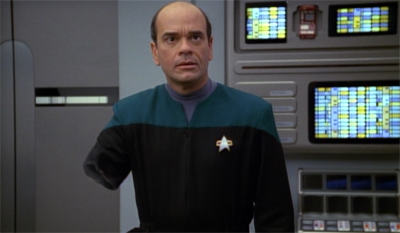


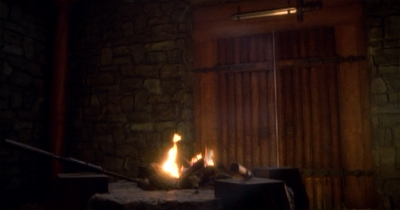

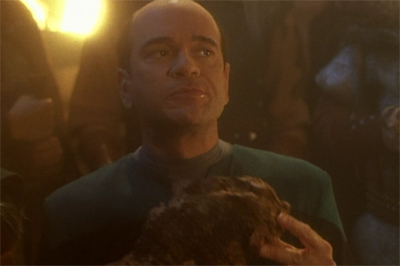
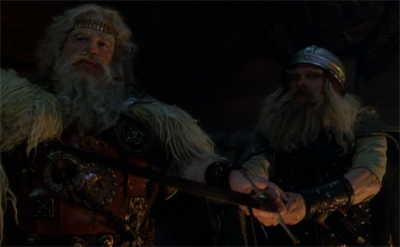



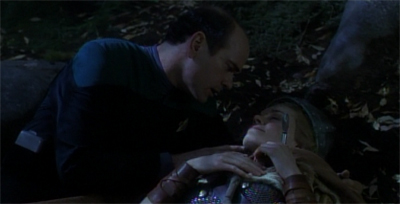
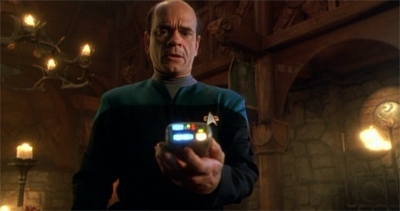



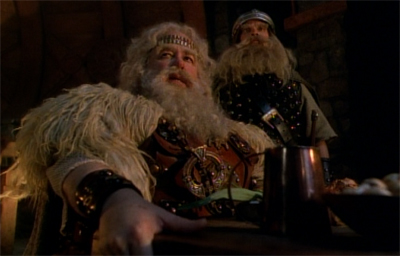






This is unrelated to “Heroes and Demons”, but I’ve been revisiting VOY of late, and what strikes me about Janeway is what a bore she is. This is a terrible indictment consider the caliber of acting we have here. In the episodes where the crew are “not themselves” (Timeless, Workforce, Nemesis, etc), the characters suddenly come alive. When confined to the real world, however Mulgrew stands on that ugly gunmetal gray bridge like a big Tetris piece; a black hole of charm, and oddly androgynous in manner. I understand that Dawson had similar gripes with her character as well.
What Star Trek doesn’t seem to understand is that femininity can often enhance, not detract, from authority is played right. Seven nailed the dominatrix angle which Braga was no doubt gunning for, and yet outside the context of titillation, she was actually a pretty strong-willed, feminist character. (Unintentionally, I am certain.) When she barked orders you stood up and paid attention. The same can be said for Janeway and Torres on a good day, but more often than not, they were just a pair of misery guts.
Yep. Had they put Seven of Nine in a science-division uniform, she would be an unquestioned feminist icon.
Then again, given the thought process behind her creation, if you put her in a science-division uniform, she wouldn’t be Seven of Nine.
However, I rewatched some of the later episodes this year, and Jeri Ryan really is phenomenal, isn’t she? I don’t mean in the superficial sort of way… okay, I don’t only mean in that way. I mean in the sense of a dramatic performer. Ryan is perfectly cast and gives a superb performance. Granted, she immediately got the best material, but she was just perfect for that role.
And it’s not entirely off-topic. I mean, Janeway wears her hair in the same style they’d later use for Seven. So that counts, right?
Yeah, half the enjoyment to be had from VOY is the actors, doggedly making a diamond from coal. Jeri Ryan is written as a plank of wood. As portrayed, she is a brusque and hard-headed manager who doesn’t tolerate fools. Their is a giant gulf between the “Ayn Rand in fetish gear”, one-joke character the script peddles out and the rich performance we actually get. She combines the best qualities of Data and Spock, in my opinion.